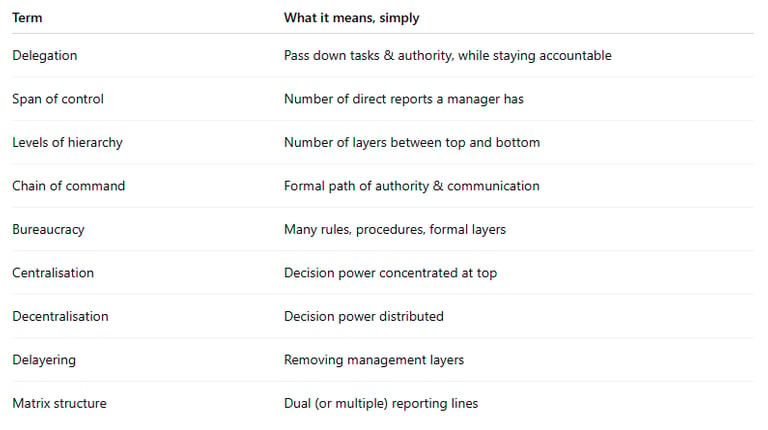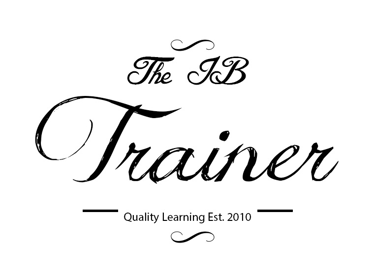Speak Business Key Organisational Structure Terminology You Must Know
Master the key organisational structure terms - delegation, span of control, centralisation and more - with real examples and stories for IB Business students.
IB BUSINESS MANAGEMENTIB BUSINESS MANAGEMENT MODULE 2 HUMAN RESOURCE MANAGEMENT
Lawrence Robert
10/13/20254 min read


Speak Business: Key Org-Structure Terminology You Must Know
“When I got promoted, I thought I’d just boss people around. Turns out, I had to learn how to delegate - and badly at first.”
That was me, in my first mid-sized firm, fumbling with handing off tasks I’d always done myself. I’d ask people to do things, then micromanage. Big mistake.
Over time I realised that knowing the “lingo” - span of control, chain of command, decentralisation, etc. - isn’t just textbook fluff they gave me at college. In reality, it’s basically what keeps organisations from collapsing into chaos.
So - today we will cover the terminology behind organisational structures. Today, we’re not drawing charts or debating whether Uber should centralise or decentralise. Instead, we’re giving you the vocabulary so that when you do talk about structures, you sound like you know what you're doing.
Delegation - The “let go, but still watch” skill
Let's imagine for a sec you’re the head of a school technology club (or band, or YouTube project). You realise you can’t do everything - you need help. So you ask one of your members to handle social media. You don’t micromanage every post, but you’re still responsible if something goes wrong (like when you post a meme that offends 75% of the school).
That’s delegation. You pass down authority (so the person can make decisions), but you retain ultimate accountability. You’re still responsible if things go south.
Why is this useful?
It frees you up for bigger-picture tasks.
It can motivate people (they feel trusted, they feel they can contribute and bring value).
But - you can’t delegate your responsibility. If the social media post backfires, it’s on you.
In real firms, CEOs rarely do every decision. They delegate to middle managers, but still get in trouble if those managers mess up.
Span of control
This is about “how many people you can realistically manage directly before you reach that mental stage where you don't know where you are.” If you ask one person (a line manager), “how many subordinates report to you?” - that number is your span of control.
Wide span = you manage tons of people.
Narrow span = just a few direct reports.
If your span is wide, you risk being overstretched; if narrow, you end up with many management layers (which can slow things down).
Analogy: Think of a teacher in a class. If a teacher had 60 students, that’s a wide span - hard to give attention. If they had 5, that’s narrow, but then you’ll need more teachers.
Levels of hierarchy
Ask: how many “layers” are there between the top boss and the newbie making the tea in the mailroom? That’s levels of hierarchy - from senior executive, to mid-management, to supervisors, to base workers.
Tall hierarchy = many layers.
Flat structure = few layers.
In tall structures, communication has to pass through many levels (think “Chinese whispers”). Flat ones are more direct, but managers might get stretched.
Chain of command
This is the formal “who tells who” path. It runs top → bottom for orders, and bottom → top for accountability and reporting.
If your school club captain tells a deputy, who tells a treasurer, who tells volunteers - that’s a chain of command.
Clear chains help ensure decisions don’t get lost or reversed half-way down the ladder.
Bureaucracy
When you hear “bureaucracy,” many roll their eyes. It’s like the red tape, rules, paperwork, formal systems - all that “by the book” stuff.
In bureaucratic organisations:
Many layers of management.
Lots of formal rules and procedures.
Decision making often centralised.
But slow to react, stifles humour & innovation.
In public sector or big government agencies you’ll often see bureaucracy. The downside: when the environment changes (new tech, new competitor), bureaucracy might drag your feet.
Centralisation vs Decentralisation
These are kind of opposites along a spectrum.
Centralisation: decision power is concentrated at the top.
Pros: consistency, control, quick top decisions.
Cons: slow for local issues, demotivates staff, overloads top.
Decentralisation: decision power spreads to middle / lower levels.
Pros: faster local decisions, more autonomy, staff feel empowered.
Cons: risk of inconsistent decisions, bad choices by less experienced staff.
IB Business Management Real-world examples: Coca-Cola operates with a mix: for global brand or major policy decisions, the head office (central) takes charge; but local branches decide local ad campaigns, promotions, based on local tastes.
Also, during COVID in the UK, critics said the NHS procurement was too decentralised (so local hospitals made conflicting buying decisions), while testing & tracing was overly centralised, creating bottlenecks.
In fact, many organisations “swing” - they centralise some things, decentralise others, depending on what’s strategic vs routine.
Delayering
Imagine cutting out some management levels. You remove a “middle manager” layer, making communication shorter and reducing costs. That’s delayering.
Pros: flatter structure, faster decision making, lower costs.
Cons: employees might get extra workload, stress, confusion in roles.
Many tech and startup firms prefer flatter organisations, so they frequently delayer.
Matrix structure
This one’s a bit trickier (but as students often say, cool). In a matrix structure, employees may report to two (or more) bosses:
One boss for function (e.g. finance, HR),
Another for project or product.
So you might be a finance specialist but assigned to a product team. You balance reporting lines.
Pros: flexibility, resource sharing, synergy across departments.
Cons: confusion over who is your real boss, conflicting instructions, slower decision making when lines cross.
Many high-tech, R&D, or project-based firms adopt matrix structures.
Pulling it all together (mini evaluation guide)
Whenever you see or hear a structure, think:
Who makes decisions? (central vs decentral)
How many levels? (hierarchy)
How many direct reports? (span)
How formal are rules? (bureaucracy)
Are there multiple reporting lines? (matrix)
Have layers been cut recently? (delayering)
And: was authority passed (delegation)?
In your IB Business Management essays or case studies, always apply these terms to the particular business. Don’t just define - ask:
Does this business benefit from centralisation (e.g. consistent brand)? Or is decentralisation better because it’s in a fast-changing market?
Would delayering help reduce costs or overload staff?
Real-life “fun” anecdote
I once chatted with someone working at a major gaming company (let’s call them GameX). They said their team had four managers above them. They spent more time in meetings about who reports where than actually building games. When management tried to delayer (cut one level), suddenly many decisions got made much faster - fewer meetings, fewer approvals. But some team members freaked out because they didn’t know which boss to ask.
That little human frustration is exactly why knowing the lingo matters: you understand why they felt lost.
Quick recap (your glossary cheat sheet)
Stay well,


IB Complete Support Courses, a new generation of affordable support materials directed at IB students seeking grades 6 or 7.
© Theibtrainer.com 2012-2025. All rights reserved.
